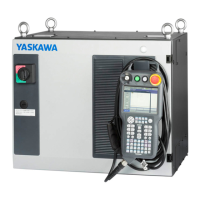11 Safety Function
11.7 Setting Example of the Safety Functions
11-112
HW1485509
HW1485509
4. Once you have completed your changes press {READBACK} to
readback the data. Check the readback data is correct, then press
{WRITE} to save your setting.
5. Press the {MENU} button on the top left, select Safety Settings, and
select Safety Functions.
6. Select {+ NEW SETTING} at the top of the Safety Function Settings
screen, select {ROBOT RANGE LIMIT}, then press {CREATE NEW
SETTING} to open a blank Robot range limit.
7. Give the Robot range limit a relevant name such as “Low Speed Area”.
Change the {Action} to “Status” to mute the alarm even if the Robot
move into this area. Change the shape type to cubic for this example.
Change the {Monitor Type} to “Keep Robot Outside”. If you select
“Keep Robot Outside”, outside of the specified will be defined as safe
area, you can detect the Robot entering the area. Change X,Y,Z of the
Point 1 and Point 2 to specify the area for reducing the Robot speed.
8. After changing the Action to Status, the “Advanced Settings” screen
will pop-up and you can select a signal for your “Output Signal” drop-
down.
9. Select the “Virtual Discrete Safety I/O” tab and choose the FSOUT01.
10. Once you have completed your changes press {READBACK} to
readback the data. Check the readback data is correct, then press
{WRITE} to save your setting.
11. Confirm the output signal is changed by Robot position as specified
area. After confirmed, press {CONFIRM}.
12. Press the {MENU} button on the top left, select {Safety Settings}, and
select {Safety Logic Circuit}.
13. Select {+ NEW LOGIC} at the top of the Safety Logic Circuit screen.

